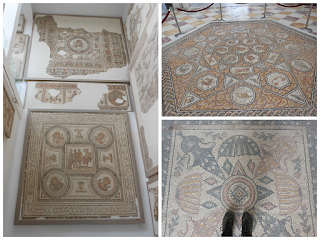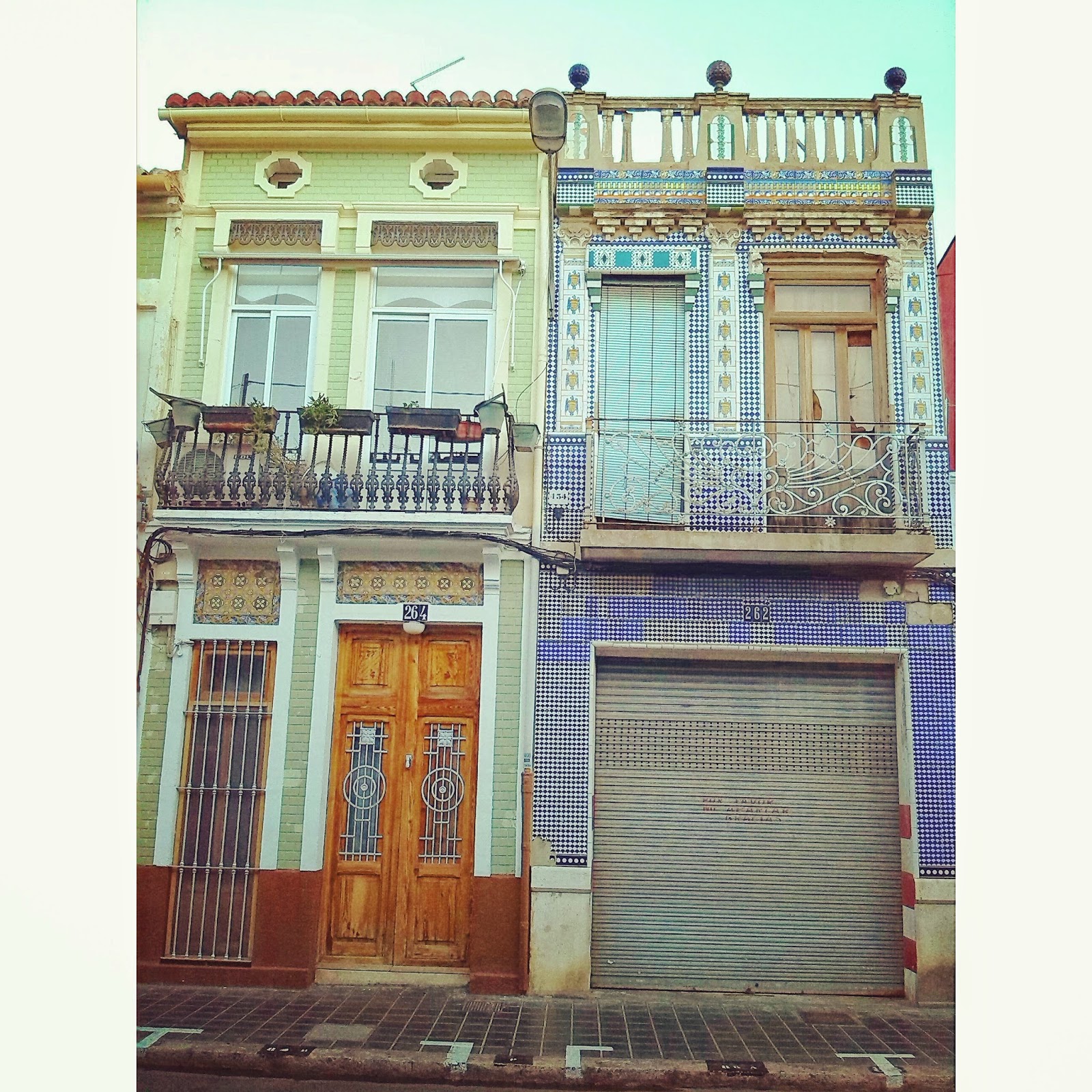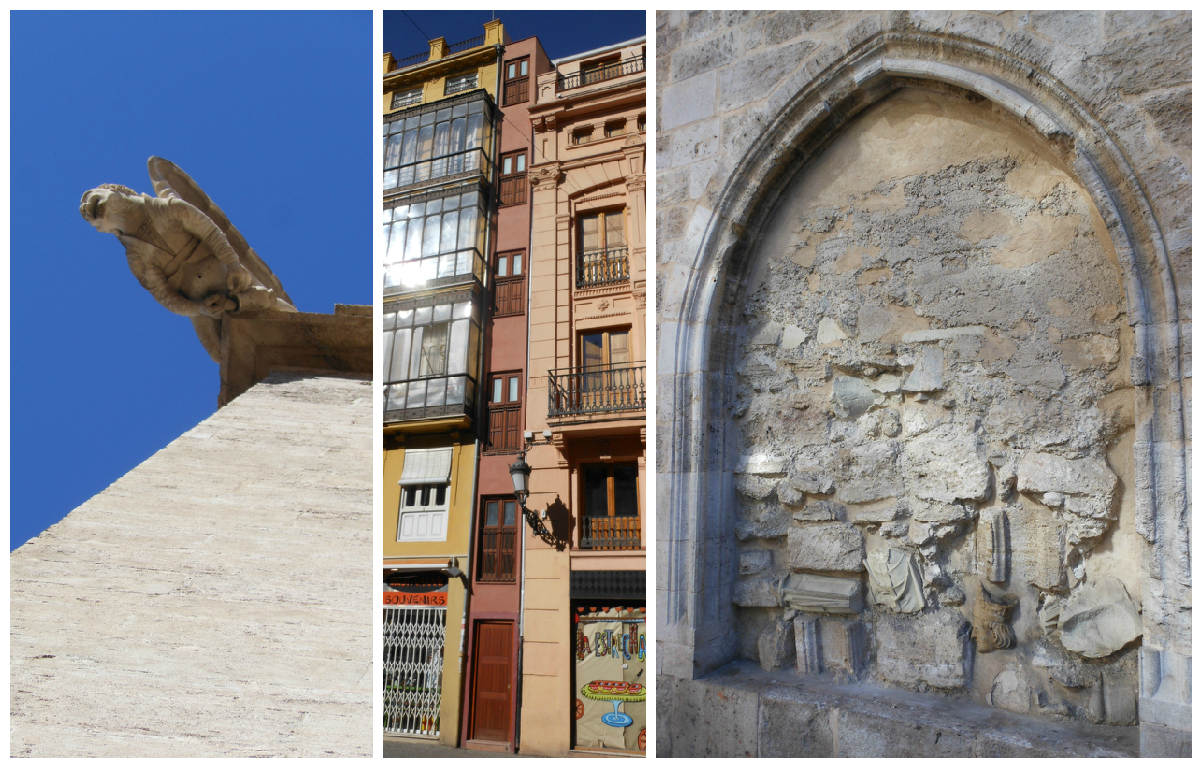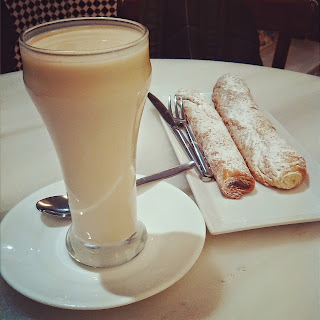If you're like me, your first reaction to hearing about someone who went to Tunisia is probably something like this: "What? Who goes to Tunisia? Is it safe? What is there to see there?" It never would have occurred to me either, until Tunis showed up when I was searching different sites for the cheapest destinations on one of our long weekends. My first reaction was the one above - Tunisia!? - but after doing some research, I quickly became convinced I should go. For one, the long weekend was in the middle of February, a terrible time to travel anywhere north of Spain (aka all of Europe) because of the miserable weather. For another, I discovered that the ruins of Carthage, a huge collection of Roman tile mosaics and many beautiful Islamic buildings were some of the top attractions in Tunis, and after talking with my roommate and our friend Melanie, we decided to give it a go!
 |
| A panoramic view of "downtown" Tunis from a rooftop bar |
Tunisia is in Northern Africa, between Libya and Algeria. If you read my post about Marrakech, then you can imagine it being somewhat similar in culture and history to Morocco. Most people speak French and Arabic and practice Islam. But Tunisia is actually one of the most non-conservative, non-traditional Muslim nations in the world - so much so that, according to our new Couch Surfing friend who we met there, hard-line countries like Saudi Arabia hate them almost as much as they hate "the West" because they see Tunisians as misrepresenting the religion. Our experience seemed to confirm this assumption: we saw a few bars where people seemed to have no qualms about drinking alcohol, very few women wearing headscarves, and most people dressed in more or less Western-style clothes, a big contrast to Morocco, where many people wore "traditional" outfits and alcohol was difficult to find.
 |
| Some pictures of "downtown" Tunis |
If you have an idea in your head of Tunisia being unsafe, chances are it might be due in part to something you've heard about all the so-called "Arab Spring" revolutions which shook many North African countries a few years back, and which have made countries like Libya, Algeria and Egypt questionable travel destinations. But Tunisia, as you would quickly learn upon doing some research, has had a very different trajectory from these other countries, and has been hailed as the exception. Tunisia was actually the first country to spark these various revolutions; a Tunisian man led to desperation and fed up with the government's abysmal policies set himself on fire and sparked mass protests, later called the "Jasmine Revolution," and which eventually led to the ousting of the dictator Ben Ali. Perhaps because they were the first, or perhaps for some other reason, Tunisia has been one of the only countries to come out more or less safely (and relatively quickly) into a new "stable," "democratic" government. The reality may not coincide exactly with this nice media-painted idea, but in general Tunisia is no longer racked by conflict and strife and, until recently, has had almost no incidences of terrorist attacks.
 |
| An image from Google of the "Jasmine" Revoluation |
We were actually quite excited to see a country at such a pivotal moment in its history - granted, the revolution was four years ago, but needless to say its effects are still being negotiated and unraveled today. However, the reality was not so pleasant. On the ground, at least as a tourist, the main effects which you see of the revolution are not an improvement in justice or the economic situation, but rather a disintegration of basic social mores: traffic is horrendous and terrifying, with nobody respecting stoplights or basic rules of driving; so many streets, public squares and parks are absolutely disgusting, filled with piles and piles of refuse. According to people we talked with, it did not use to be like this. When everyone was terrified of the dictator and his harsh punishments, people respected the laws; now, when they know they can simply pay off a corrupt police officer to drop the charges, they do whatever they want with no fear of legal consequences. The picture of trash below is from Google, but it accurately depicts what we saw while there - it may look exaggeratedly bad, but sadly we found it to be the rule rather than the exception. Piles like this or worse were absolutely everywhere we went.
 |
| A picture from Google of a filthy street in Tunis |
I don't want to dwell too much on negative things, but unfortunately these circumstances, among others, did color our trip for the worse and, without our desiring so, befouled our impressions of the beautiful things which we did see. The one thing I will say was that everyone we met was incredibly nice. We had multiple offers from people on Couch Surfing to meet up and show us around, and we ended up hanging out with one guy named Alâ every single day we were there. He guided us around and shared his extensive knowledge of the country's history, acting as our own personal tour guide, which was incredible and incredibly nice of him. But everyone else was friendly as well: from taxi drivers to our AirBNB hosts to random people we interacted with on the street. Not only were people friendly, but they seemed very concerned about their country's international image. "How do you like Tunisia?" was almost always the first question everyone asked, with great anxiety lest you should say something negative. Perhaps this is because they are proud of their country, or perhaps it's because tourism is a huge part of the national economy and they are concerned about people not coming, but either way it was probably the most positive thing I found in Tunisia, which at least in part made up for the other less ideal things.
The Arab Palace
 |
| Photomontage of the Arab Palace |
One of the highlights of our trip was probably the amazing AirBNB where we stayed. It was an old palace of the kings of Tunis which has been converted by two French designers into a gorgeous bed and breakfast style lodging. They called it an "Arab Palace" online and we truly felt like royalty while staying there. They fed us an extensive and delicious breakfast every morning, and even made special things for our friend who is gluten intolerant. Its extremely chic, designer vibe also made us feel like we were living inside a fashion magazine, and inspired us to take lots of silly pictures, which you can enjoy below.
 |
| Imitating photos in the Arab Palace |
 |
| Elvis in the Arab Palace |
 |
| Being silly in the Arab Palace |
The Bardo Museum
The most famous tourist attraction in Tunis is without a doubt the Bardo Museum, and at least for me, it did not disappoint. The museum's collection, while immense and extensive, consists almost exclusively of Roman tile mosaics, something which might sound strange to you if you think about it - Roman ruins in North Africa? I thought the Roman Empire was in Europe?
 |
| A portrait of a patroness, almost perfectly preserved |
One thing I learned in one of my college courses, and which kind of blew my mind, was that North Africa was not only part of the Roman Empire, but was actually the cultural and artistic center in the centuries following Jesus' death, while Europe became a backwaters. Thus, some of the most amazing Roman art and architecture today is not in Europe at all but in countries like Tunisia, Libya and Syria.
 |
| More incredibly detailed mosaics |
In addition to their collection, the building itself was breathtaking, as it had once been a palace and therefore boasted gorgeous, intricate decorations in many of the rooms. The very distinct, Islamic style of adornment reminded me a lot of certain buildings in Morocco.
 |
| The beautiful interior of the Bardo |
The museum was impressive to me both for the remarkably intact state the majority of the mosaics were in, as well as for the sheer mass of them - they were literally everywhere, on the floor, on the walls, and in many places spreading across multiple stories of the same wall, and/or across multiple walls of the same room because they were so enormous. Considering that most of these works date from the first to sixth century after Christ, it was so incredible and amazing to me that there were so many of them and that they were so well preserved!
 |
| Mosaics everywhere! |
Carthage
More Roman ruins! When I first learned that the ruins of Carthage were in Tunis, I was super excited about seeing the remains of a non-European civilization, something I've never really experienced before. I did some research before I went, downloading a few podcasts on Carthage's history, and soon learned that the original city was completely and utterly obliterated by the Romans. So, unfortunately, what you see today are actually just more Roman ruins like what you can see in Italy or throughout Europe. OK, I can't complain about that, but it would have been cool to see something from a civilization which you don't often hear about.
 |
| The ruins of Carthage |
The ruins were nice, albeit much smaller than we were expecting and not exactly well preserved. Similar to our experience in Morocco, we found Tunisia's approach to preservation and museumification questionable and a bit disconcerting. However, you can't argue that the views were pretty incredible! There was also a 19th century cathedral dominating the hill next to the ruins, a leftover from the French colonial days.
 |
| Cathédrale de Saint Louis |
Sidi Bou Saïd
My favorite part of Tunis was the small seaside village of Sidi Bou Saïd, with its picturesque whitewashed houses and striking blue shutters. There is actually a strict ordinance in the town that forbids people from painting any building in a different color scheme, so that the full effect remains untainted.
Sidi Bou Saïd is known for being a slightly bohemian, alternative village, which has attracted artists and craative types, both Tunisian as well as French, throughout its history. It has a really nice feel and, aside from the lovely buildings, also boasts beautiful views of the Gulf of Tunis, which we were fortunate enough to see at sunset.
 |
| Sunset over the Gulf of Tunis |
 |
| More beautiful views |
We also visited a cool place called Dar el Annabi, an old house that has been converted into a museum of Tunisian culture, with displays of traditional outfits and home decors which were used historically in the country.
 |
| Being silly in Dar el Annabi |
They also had a lovely area where you could drink tea:
 |
| Drinking tea in Dar el Annabi |
...and an awesome rooftop with amazing views of Tunis off in the distance.
 |
| Rooftop view in Dar el Annabi |
La Médina & La Marsa
We spent our last day exploring the medina, or historical city center, which is a UNESCO World Heritage Site and which boasts tons of mosques and other interesting governmental buildings. We enjoyed taking silly pictures and buying some yummy Tunisian sweets, but unfortunately most things were closed as it was Sunday.
 |
| Scenes from the medina |
 |
| More medina scenes |
Finally, we headed down to La Marsa, a small stretch of public beach which is usually popular, but was fairly deserted due to the chilly, cloudy weather. And that was more or less the end of our trip.
 |
| On the beach at La Marsa |
In spite of the many things that put a damper on our trip, I can't deny that we did get to see a lot of beautiful things. Even if there were some things we didn't like that much about Tunisia, in the end it all makes for some interesting stories and a very enriching glimpse of a country completely unlike any I've ever seen before.




































